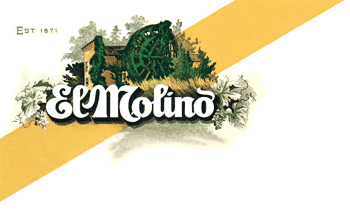
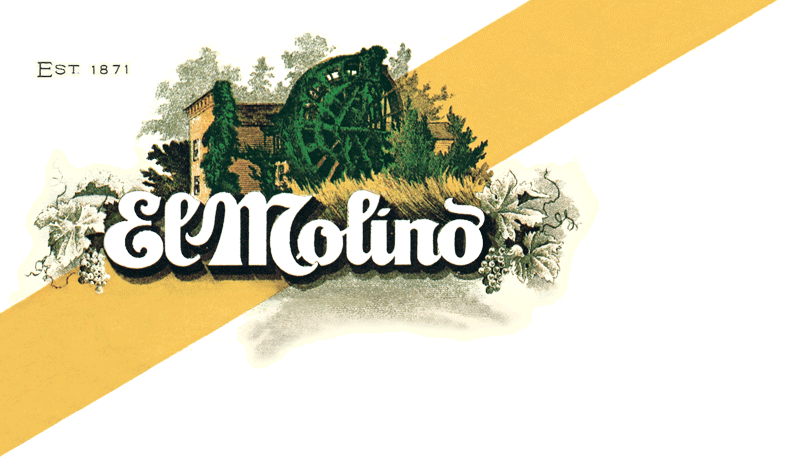
Story
The
Early Years
1841-1871
Dr. Edward Turner Bale (1810-1849), an English physician, landed at Monterey in 1837 and practiced medicine there for five or six years. In 1840–43 he was surgeon of the California forces by General Mariano Vallejo's appointment. He married Maria Ygnacia Soberanes, niece of both General Mariano Vallejo and Mariano's brother, Salvador Vallejo. Through General Vallejo's influence, Bale obtained a four league grant of Rancho Carne Humana in Napa Valley in 1841. (1 league equals 4,428 acres)
Dr. Bale and his family moved to his Rancho in 1843 and Dr. Bale began work on a water-powered grist mill. This milling operation was a focal point for the settlement of the Napa Valley, whose economy during this period centered on the production of wheat and its milling into flour. The mill's buildings served as the location for political meetings and social activities.

Florentine Erwin Kellogg, a native of Batavia, New York, moved to California in 1846 with his third wife, traveling by wagon and crossing the summit of the Sierra Nevada just as a snow storm was starting, which in a few days imprisoned the ill-fated Donner Party. He settled on what is now El Molino, building the house presently occupied by the Lyman family, founders of the winery. Kellogg did all the iron work on the original grist mill in 1846 and ’47 for Dr. Bale, in part payment for his ranch, receiving 600 acres. In 1848 he planted 2 acres of Mission grape vines, the first vineyard of any size planted in Napa Valley.
Bale had often used land in payment for services rendered. His family was financially pressed after his death and his widow battled in the courts for decades to hang on to what was left of the original grant. Interestingly, Bale left to his sons his cattle, since they were of greater value at the time than land, and to his daughters he left tracts of property to serve as their dowries. Upon one such piece, just north of St. Helena, his daughter Caroline Bale and her husband Charles Krug planted grapes.
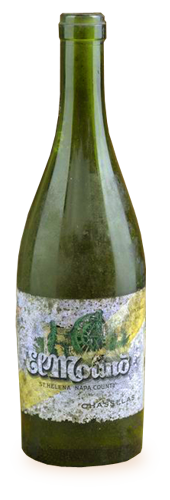
Original El Molino Bottle Pre 1900
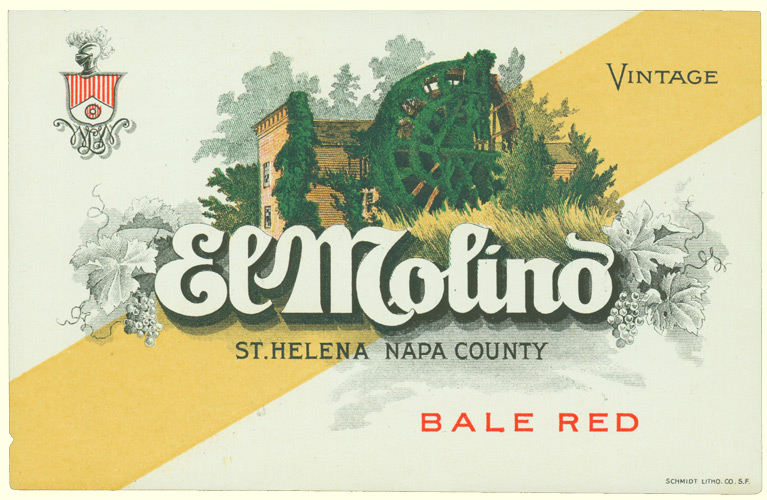
Original El Molino Label Pre 1900
1871-1910
In 187l, Colonel W. W. Lyman bought the Bale Mill from Captain W. Sayward and built the wine cellar on the property, completing it in time for the harvest. Chinese laborers, left in California after the completion of the trans-continental railroad, dug the still-existing tunnel, constructed the cellar and later worked in harvest and in the winery. Almost all the wine was in bulk and much of it was sent to the Napa Valley Wine Company in Oakville, of which Mr. Lyman was an investor. There it was bottled and sent by rail to San Francisco. During this period, Mr. Charles Krug offered the most advice to Colonel Lyman.
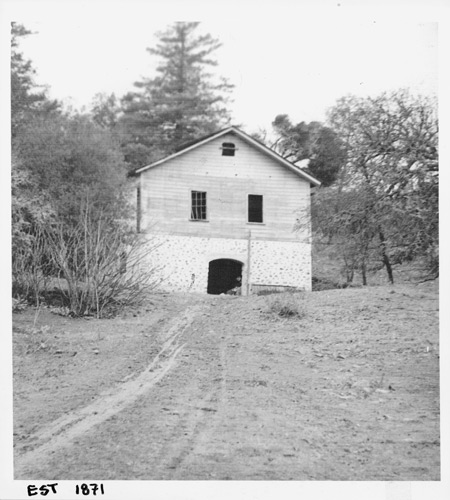
El Molino During Prohibition
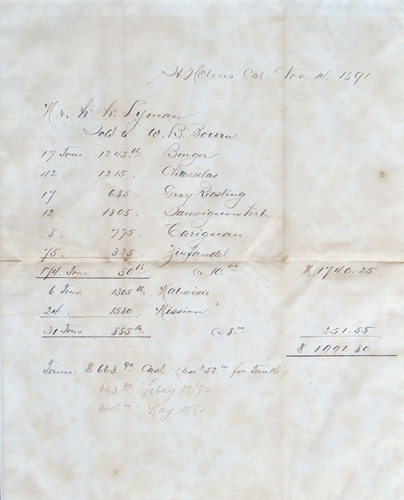
El Molino Grape Bill of Sale, 1891
Recollections
of the late
W. W. Lyman, Jr.
Son of El Molino Founder
The Cellar
“The wine cellar was of two stories built against the hillside. The road constructed behind it was level with the second storey. There was a platform between this road and the building on which was a wine-press of the hydraulic type, and it was in this that the grapes were crushed. The wagons hauling the grapes from the vineyard unloaded at this spot.
The area of the press was about six feet in diameter. Around it was a structure of wooden slats and inch or so broad with an interval between and in vertical position, and the juice oozed out through these openings and ran into open casks. The larger casks were placed on the ground floor. The smaller casks held about 250 gallons. I remember that a number of these came from Los Guillicos Rancho in Sonoma County when that ranch went into liquidation.
About 1897, my father built a tunnel into the hillside of about fifty feet in length. The first twenty feet was walled and the inner thirty feet held wine casks. The inner portion has now caved in. When the tunnel was in operation, there was an air hole from the top into the inner portion about two feet in diameter and of about twenty feet in length. This was left unprotected. We children used to gaze into it and imagine how it would be to fall in! Fortunately no one ever did.
The wine cellar operated until about 1910. I have a wine label dating 1879. The capacity of the wine cellar was 40,000 gallons. Most of the wine made was sold off in bulk, but a small proportion was bottled with appropriate labels. I have labels denoting the following varieties: Zinfandel, Riesling, Napa Claret, and Bale Red.”

Cellar Converted to Residence, Front

Cellar Converted to Residence, Side
The Vineyards
“I recall that our vineyards included such white grapes as Green Hungarian, Sauvignon Vert, malvasia, Burger, golden Chasselas, and Muscatel. The red varieties included Zinfandel, Cabernet Sauvignon, Mattaro, and carignane. There was a larger percentage of Zinfandel than any other variety. We had a number of table grapes such as Black Hamburg, Rose of Peru, Muscat, Malaga, Tokay, and Victoria. My favorite of the eating grapes was rose of Peru, round in shape and of several shades of purple. In general I preferred the wine grapes to the table grapes.
Our vineyards were planted both on the hillside and in the valley. My father, as soon as the property was under his control, cleared off the forest on fifty acres of hill land reaching up from the county road. This contained deep red soil eminently suited to grape culture, and he planted out a variety of grapes. He also planted thirty acres in the valley below the sugar-loaf hill. There was also ten acres where there is now an olive orchard opposite our house and garden. There was also a vineyard at the extreme southeast corner of the ranch between the railroad and the east of the Ehlers property. About the year 1895, my father extended the hill vineyard over the brow of the hill.
The vineyards were in full operation up to the year 1900. Then they began to succumb to phylloxera. Those in the valley were the first to go. Portions of the hill vineyard were in bearing as late as the year 1942.”
1945-1976
“After 1910 the remaining grapes were sold to other wineries. The cooperage in the wine cellar was sold shortly before my father’s death which occurred in 1921. After that the lower portion of the winery stood empty or was used for storing hay. As the years passed, the empty cellar became the victim of time and chance. The front door fell from its hinges, and cattle and horses wandered in and out. In 1943 the wine-cellar and surrounding five acres were sold to Mr. and Mrs. Van Allen Haven. They proceeded with fine taste and discretion to mold it into a unique dwelling place which is the admiration of all who visit it.”
Van Allen Haven had worked as a commercial artist in San Francisco, while Nancy Back Haven did sales and marketing for Louis Martini Winery. She was active in wine circles and was the first woman president of the Napa Valley Wine Library.

Nancy & Van Haven Entertaining, 1950’s
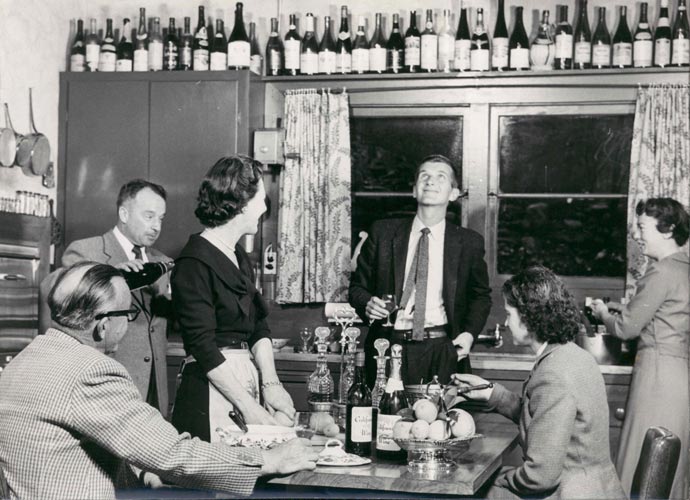
Further Libations
The
Reg Years
1976-2005
On Nancy’s death in 1976 her estate put the property up for sale where it remained until Reginald and Marie Oliver bought the winery and surrounding land in 1978. Nancy’s nephew, Reg, was born in Berkeley and spent his childhood in Los Gatos, making occasional trips to visit Aunt Nancy in the Napa Valley. He caught the wine bug early in life, purchasing a wine press in his teens and making wine in the family barn. During his teens he also worked a summer construction project at the Paul Masson Winery building a sparkling wine cellar. He left California, however, in 1961 to work as a securities analyst in New York City. During that time in New York he would conduct tastings of Californian wines for colleagues and apparently poured noted wine writer Terry Robards his first glass of California Chardonnay. With his wife, Marie, vacations were spent exploring France, particularly Bordeaux and Burgundy.

Reg and Marie Oliver
In 1981, the Olivers moved with their children to St. Helena to the El Molino Winery property. The original caves were excavated by hand by digging 45 feet down into the hillside to locate the back of the tunnel. Two floors were placed above the original cave so as to create a gravity flow cellar in the Burgundian tradition. Refining his winemaking from 1981 to 1986 Reg made home wine from Pinot noir, Chardonnay and Zinfandel in the family carport as construction of the winery was underway. The cellar renovations were completed in time for the 1987 harvest. Pinot noir was made the first year and a Chardonnay was added in 1988.
In 1987, a partnership with close friends enabled the purchase of Star Vineyard in Rutherford. The 68 acre vineyard has 30 acres of Chardonnay, the first block planted in 1978, with the remainder in Cabernet Sauvignon. Ignoring all advice Reg pulled some vines and planted the first 2 acre block of Pinot noir and later adding another 4 acres. The Pinot vines are not far from the famous BV1 block from which Andre Tcheliecheff made his acclaimed Pinot Noirs in the 1940’s.
In the early 1990’s, Reg decided to renovate a dilapidated wood shed and kiln of Van Haven into a Chardonnay cellar and storage warehouse to age the bottled wine. The Chardonnay now has its own dedicated space which is particularly valuable in inhibiting the malolactic fermentation which we are so passionate about. All the wines now cellar on property until release.
In 2005, after a long battle with melanoma and eighteen successful and acclaimed vintages, Reg passed away leaving the winemaking to his daughter and son-in-law, Lily Oliver Berlin and Jon Berlin.
The
Present
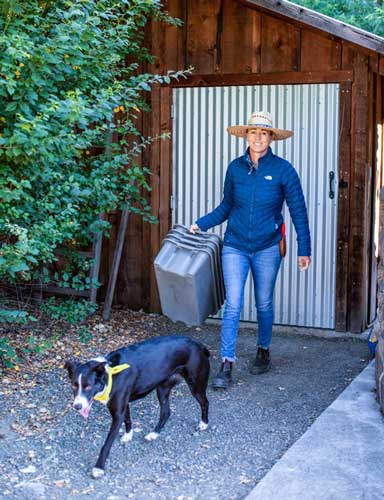
Lily Oliver Berlin
Lily was born in Manhattan and moved with her family to El Molino when she was nine. The old ghost winery had been converted to a home by her Great Aunt Nancy shortly after the end of Prohibition and with Nancy's death, her parents moved into the historic property. Since child labor was never frowned upon, there was a lot to be learned in the age-old tradition of apprenticeship under her winemaking father over the years. After a bachelor's degree from Pepperdine University, she worked at Sherry Lehmann Wines & Spirits on Madison Avenue, confirming that city life fell short to the charms of the country, and returned to El Molino. Lily continues to touch all aspects of the business today.
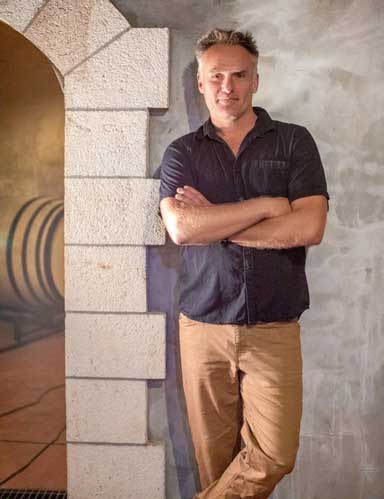
Jon Berlin
Born and raised in South Africa, Jon hightailed out of landlocked Johannesburg the day he took his drivers permit and headed for the cool waters and fine wines of the Cape of Good Hope. After completing his national service in the South African Navy, he undertook a graduate degree in Surfing and Surfboard Construction from the school of life, culminating in a board building business and a permanent tan. Realizing that his wine tastes had outgrown his income, Jon jumped ship, closed the factory and started working in the restaurant business in Stellenbosch and Franschoek.
Through a chance meeting late one Sunday evening with a winemaker on his way to do a stage in France, Jon had his wine epiphany with a bottle of 1999 Flagstone BK5 Pinot Noir. The following Tuesday Jon met with owner Bruce Jack and was offered a cellar rat position at Flagstone, which he jumped at!
After completing harvest with very little sleep but a head full of wine nous, Jon heeded Bruce’s advice to experience “Jimi Hendrix played backwards at 45rpm" by heading for the land of opportunity and a harvest position at Flowers Vineyard and Winery on the Sonoma Coast.
High on the harvest life Jon bounced between the hemispheres, completing six successive vintages in South Africa, California, New Zealand and Australia. He topped it off with Post Graduate studies in Viticulture and Oenology from Lincoln University in Christchurch, New Zealand.
Jon was the winemaker at Viader, Napa Valley, from 2004 to 2006 and has consulted with Bello Family Vineyards and Kristine Ashe Vineyards among others.